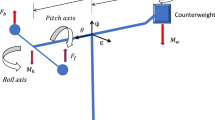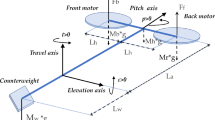Abstract
A helicopter flight control system is a typical multi-input, multi-output system with strong channel-coupling and nonlinear characteristics. This paper presents an explicit model predictive control (EMPC) for attitude regulation and tracking of a 3-Degree-of-Freedom (3-DOF) helicopter. A state-space representation of the system is established according to the characteristics of each degree-of-freedom motion. Multi-Parametric Quadratic Programming (MPQP) and online computation processes for explicit model predictive control and controller design for a 3-DOF helicopter are discussed. The controller design for set-point regulation and tracking time-varying reference signals of a 3-DOF helicopter are presented respectively. Numerical study of explicit model predictive control for attitude regulation and tracking of a 3-DOF helicopter are conducted. A hardware-in-the-loop experimental study of explicit model predictive control of a 3-DOF helicopter is made. To analyze the performances of an EMPC controlled helicopter system, an Active Mass Disturbance System and manual interference are considered in comparison with PID scheme. Numerical simulation and HIL experimental studies show that explicit model predictive control is valid and has satisfactory performance for a 3-DOF helicopter.
Similar content being viewed by others
References
A. T. Kutay, et al., “Experimental results on adaptive output feedback control using a laboratory model helicopter,” IEEE Transactions on Control Systems Technology, vol. 13, no. 2, pp. 196–202, March 2005. [click]
B. Zheng and Y. Zhong, “Robust attitude regulation of a 3-DOF helicopter benchmark-theory and experiments,” IEEE Transactions on Industrial Electronics, vol. 58, no. 2, pp. 660–670, March 2011. [click]
M. Ishitobi, M. Nishi, and M. Miyachi, “Nonlinear model following control with parameter identification for a 3-DOF model helicopter,” Proc. of IEEE/ASME International Conf. Advanced Intelligent Mechatronics, pp. 1–6, 2007. [click]
I. Postlethwaite, I. Prempain, E. Turkoglu, C. M. Tuner, K. Ekkis, and A. W. Gubbels, “Design and flight testing of various h-infinity controllers for the Bell 205 helicopter,” Control Engineering Practice, vol. 13, no. 3, pp. 383–398, March 2005. [click]
H. Sira-Ramirez, M. Zribi, and S. Ahmad, “Dynamical sliding mode control approach for vertical flight regulation in helicopters,” IEEE Proceeding Control Theory and Application, pp. 19–24, 1994. [click]
M. Morari and J. H. Lee, “Model predictive control: past, present and future,” Computers & Chemical Engineering, vol. 23, no. 4-5, pp. 667–68, May 1999. [click]
Quanser Inc., 3-DOF Helicopter Laboratory Manual, 2011.
Quanser Inc., 3-DOF Helicopter User Manual, 2011.
A. Bemporad, M. Morari, V. Dua, and E. N. Pistikopoulos, “The explicit linear quadratic regulator for constrained systems,” Automatica, vol. 38, no. 1, pp. 3–20, January 2002. [click]
M. T. Cychowski and K. Szabat, “Efficient real-time model predictive control of the drive system with elastic transmission,” Control Theory & Applications, IET, vol. 4, no. 1, pp.37–49, January 2010. [click]
A. Grancharova and T. A. Johansen, “Design and comparison of explicit model predictive controllers for an electropneumatic clutch actuator using On/Off valves,” IEEE/ASME Transactions on Mechatronics, vol. 16, no. 4, pp. 665–673, August 2011. [click]
C. Panos, K. I. Kouramas, M. C. Georgiadis, and E. N. Pistikopoulos, “Modelling and explicit model predictive control for PEM fuel cell systems,” Chemical Engineering Science, Vol. 7, no. 1, pp. 15–25, January 2012. [click]
P. TØndel, T. A. Johansen, and A. Bemporad, “Evaluation of piece wise affine control via binary search tree,” Automatica, vol. 39, pp. 743–749, May 2003. [click]
F. Bayat, T. A. Johansen, and A. A. Jalali, “Flexible piecewise function evaluation methods based on truncated binary search trees and lattice representation in explicit MPC,” IEEE Transactions on Control System Technology, vol. 20, no. 3, pp. 632–640, April 2012. [click]
T. A. Johansen and A. Grancharova, “Approximate explicit constrained linear model predictive control via orthogonal search tree,” IEEE Transactions on Automatic Control, vol. 48, no. 5, pp. 810–815, May 2003. [click]
A. N. Fuchs, C. N. Jones, and M. Morari, “Optimized decision trees for point location in polytopic data sets application to explicit MPC,” Proc. of American Control Conference, pp. 5507–5512, 2010. [click]
F. Bayat, T. A. Johansen, and A. A. Jalali, “Using hash tables to manage the time-storage complexity in a point location problem: Application to explicit model predictive control,” Automatica, vol. 47, no. 3. pp. 571–577, 2011. [click]
Author information
Authors and Affiliations
Corresponding author
Additional information
Recommended by Associate Editor Won-jong Kim under the direction of Editor PooGyeon Park. The authors would like to thank the anonymous reviewers for their valuable comments and suggestions that help improve the manuscript. The authors would also like to thank the Automatic Control Laboratory of ETHZ for providing MPT, a Matlab toolbox for multi-parametric optimization and computational geometry. The work is partially supported by National Natural Science Foundation of China (60974042) and College Student Research Project Foundation of Zhejiang Province (G1401115042900).
Ju Zhang obtained his B.S. degree in Mechanical Engineering from Zhejiang University of Technology in 1994, and his Ph.D. degree in Automatic Control Engineering from Zhejiang University in 2005. From 2005 to 2006, he was a visiting scholar at Stuttgart University, Germany. From 2007 to 2010, he was an associate Professor, and from 2011, he is a Professor, both at college of information Engineering, Zhejiang University of Technology. From 2014 to 2015, he was a visiting scholar at Michigan State University, USA. His research interests are in the areas of model predictive control, hybrid system and linear parameter varying systems.
Xinyan Cheng obtained her B.S. degree in Measuring and Control Technology and Instrumentations from China Jiliang University in 2008 and her M.S. degree in Automatic Control Engineering from Zhejiang University of Technology in 2015. Her research interests include explicit MPC control and helicopter control.
Jiaqi Zhu obtained his B.S. degree in Automatic Control Engineering from Zhejiang University of Technology in 2015. His research interests include explicit MPC.
Rights and permissions
About this article
Cite this article
Zhang, J., Cheng, X. & Zhu, J. Control of a laboratory 3-DOF helicopter: Explicit model predictive approach. Int. J. Control Autom. Syst. 14, 389–399 (2016). https://doi.org/10.1007/s12555-014-0324-9
Received:
Revised:
Accepted:
Published:
Issue Date:
DOI: https://doi.org/10.1007/s12555-014-0324-9




